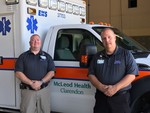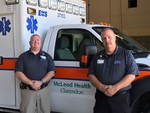


The McLeod Health Foundation received a grant from Duke Endowment in 2017, allowing them to fund the Community Paramedic Program in Clarendon County.
After a few months of initial planning, the program started this year and is well on its way to meeting and exceeding expectations, according to Emergency Medical Services Director Brad Gerfin.
Endowment directives state a goal to meet the needs of 200 unique patients over a three-year period. Four months into the program, it has already touched 30 patients with 150 home visits.
“I think we’re well on the way,” said Gerfin.
The Clarendon County program has reached out to other community programs in the state and nationwide, seeking to learn best practices as well as new methods for reaching out to the community and offering services. However, each program will have its own hurdles.
“You can’t predict with a new program like this," said Gerfin. "It’s so unique to each individual community. We take baseline information from other programs, but it’s a little different in your community."
With that in mind, Gerfin has incorporated a few new ideas, with the help of Community Paramedic Steven Denby, who works full-time on the program. Clarendon County sent two paramedics to the state-mandated training and became the first program in South Carolina to have a dedicated paramedic, with another part-time paramedic. All other programs have paramedics with dual roles.
Gerfin also instated an expanded scope of service for Clarendon County. Many programs focus on reducing ER visits by ensuring patients are following medical guidelines provided at the time of service. While the Clarendon County program keeps this as a basis for its program, it includes checking on patients admitted to and released from the hospital to ensure proper after-care, reducing readmissions.
The program also offers well-check visits for the elderly who have no local family to check on them.
“We stop by once a week or every other week with a phone call conversation once a week, just to do a well check on them, because they do have needs," said Gerfin. "They don’t meet guidelines for home health, and if we’re not there, they may have an issue with their health."
On top of this, the program pushes for community involvement to assist those whose ER usage is based upon financial or transportation needs. Denby has worked to meet with local church leaders in the community.
“Churches offer a lot of good resources to their communities, and we’re trying to tap into that" Denby said.
They are also working to partner with other agencies and transportation sites in the greater area, including a new mental health crisis unit which has come to the area to talk to Gerfin and Denby.
“So, so far, yes, I’d say we’ve had pretty good success so far. It’s still a little slow, but we’re moving,” said Denby.
Whatever the challenge, the Clarendon County program aims to get the patient to the right physician and the right places and involve them in the right programs to overcome those challenges. “It’s not just about reducing the ER visits. It’s making sure they have access to the proper care,” said Gerfin.
The program is open to several types of referral. Physicians, whether private or primary care, Mcleod-based or independent, can refer patients to the program. Mental health agencies can refer patients, and personal referrals from friends and family are coming in as well.
“This program has been accepted throughout the community and around various facilities, not just McLeod. It’s been accepted with open arms,” said Denby.
While moving forward, the program has had unexpected demands. The biggest of these has been the increased level of documentation and the time it takes, according to Gerfin. Standard documentation for paramedic situations revolves solely around what happened during the brief encounter with the patient during contact, transport and delivery to the ER staff. However, in this new program, not only do they need to document each encounter, they must also create ongoing plans for care and steps to ensure they are ready for discharge from the program.
“At the end of the day, we have to tell a story,” said Gerfin. “We will have to explain to Duke Endowment, Mcleod and the insurance companies the value of the program, so the documentation has to be able to tell that story. It can’t just be a bank of data numbers. You have to be able to touch lives with this and say this is a good program. It’s not the number of patients, but the difference we’re making in their lives.”
As the program stands now, it offers service to the entirety of Clarendon County through McLeod Health Clarendon in Manning and the Clarendon County EMS Services. However, McLeod Health is watching the outcome to assess the full benefit to the community.
McLeod Public Information Officer Carrie Anna Strange feels the hospital may consider expansion to their other service areas if the efforts in Clarendon County go well.
“There have been no complaints about the program,” said Strange. “I don’t think McLeod would let the grant go from Duke Endowment if this is not something they wanted to explore.”
The Clarendon County Paramedic Program will continue to push to meet its three-year goals, telling the story of how the service has improved the county by offering these services to the sick, elderly and members of the community in need.
“I wish there were more programs in the state, because obviously there are benefits to everywhere," said Denby. "It’s a great program."